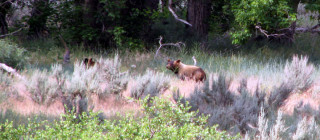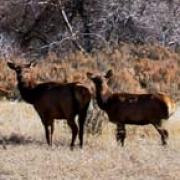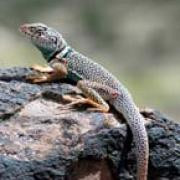Animals of Range Creek

The animals of Range Creek are completely wild and we work hard to keep it that way. Black bears in particular can quickly get used to the idea that tasty treats are available in areas where humans are active. Food, even yummy smelling lotions and shampoos, are not allowed inside tents or open vehicles and special precautions are taken to make sure that bears have no access to trash.
Range Creek is home to many different species of animals, each living in the area best suited to their needs. Many animals, especially the mammals, have a wide range of habitats but for a few it is limited. For example, moose (Alces alces) and flying squirrels (Glaucomys sabrinus) prefer the cooler and moister conditions found at higher elevations while big horn sheep (Ovis canadensis) frequent the desert terrain and cliffs of the lower canyon.

Small mammals such as deer mice (Peromyscus maniculatus), bushy-tailed pack rats (Neotoma cinerea), squirrels (Spermophilus variegatus), long-tailed weasels (Mustela frenata), and cottontail rabbits (Sylvilagus nuttallii) are frequently seen in and around the ranch complex. Mule deer (Odocoileus hemionus) browse the surrounding pastures along with coyotes (Canis latrans) hunting for mice and rabbits. In the fall they are joined by elk (Cervus elaphus) coming down from the high country to spend the winter.
At night visitors to the ranch get a chance to view, hear, or smell some of the nocturnal species that call Range Creek home. A bat census conducted by the Utah Division of Wildlife Resources in 2007 confirmed the presence of at least seven different species of bat including: Hoary bat (Lasiurus cinereus), western pipistrelle (Pipistrellus hesperus), big brown bat (Eptesicus fuscus), Towsend's big eared bat (Plecotus townsendii), and three species of the Myotis genera fringed, little brown and yuma (M. thysandes, M. lucifugus and M. yumanensis). The bats come out at dusk preforming aerial acrobatics in quest of their favorite food - flying insects. Other animals whose presence is known, but who are less frequently sighted, include skunks (Mephitis mephitis), ring-tailed cats (Bassariscus astutus), and great horned owls (Bulbo virginianus). Other elusive and rarely seen species include the black bear (Ursus americanus), mountain lion (Felis concolor), red fox (Vulpes vulpes), and bob cats (Lynx rufus) whose tracks and scats are seen much more often than the animals themselves. These animals do most of their hunting at night and spend the hot summer days snoozing in the shade.

Reptiles and amphibians are also represented in Range Creek. Garter snakes (Thamnophis sp.) and racers (Columber sp.) are common. Great Basin gopher snakes (Pituophis melanoleucus) are another commonly found species. This rattlesnake mimic in both appearance and manner feeds on mice, toads, and other snakes including rattlesnakes (Crotalus viridis) which, while present, are rarely seen. The most conspicious amphibian species in the canyon is the western toad (Bufo boreas). At night these toads leave their burrows to hunt for flying insects and ants that are snatched up using their sticky tongues. In the summer they lay their eggs in the murky still waters of the pond where their transformation from tadpole to toad takes place. Once fully developed thousands of penny-sized toads cover the ground as they move away from the water to find their new homes.
In 2004, the Salt Lake Chapter of the Audubon Society identified more than seventy bird species in Range Creek Canyon. Visitors to the ranch may spot birds of prey like golden eagles (Aquila chrysaetos) or red-tailed hawks (Buteo jamaicensis) circling far above in search of a hapless rabbit or squirrel, while ravens (Corvus corax) squawk from the branches of the cottonwoods. During the spring and fall migration, red shafted flickers (Colaptes auratus) and downy woodpeckers (Picoides pubescens) interrupt the quiet of the ranch drumming their bills against trees in search of food. Many wren, finch, and sparrow species visit feeding stations at the field station headquarters and hummingbirds keep visitors entertained watching their aerial acrobatics and aggressive antics. Larger birds like turkey (Meleagris gallopavo) and sage grouse (Centrocercus urophasianus) would have been a welcome addition to prehistoric cooking pots.